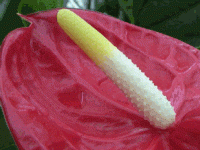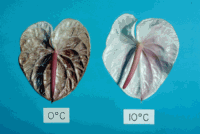Maturity and Quality
The proportion of open flowers on the spadix determines the maturity of the anthurium flower. In immature anthuriums, the spadix is smooth. Flower opening starts at the base of the spadix and proceeds upwards; spadices with open flowers are noticeably rough. Although producers in some countries harvest anthuriums when as little as 20% (1/5) of the spadix is rough, Hawaiian growers harvest flowers when only 1/4 of the spadix is still smooth (3/4 of the flowers are therefore open). Harvesting anthuriums when more mature increases overall vase life. Avoid flowers that show any signs of chilling injury (purpling of the spathe, browning or wilting of the spadix). For maximum life, flowers should be purchased when the spadix, the slender ‘tail’ of the flower, is 50 to 75 percent rough. The spadix is the true inflorescence of the anthurium, and the rough mature flowers are easily distinguished from the smooth, immature flowers.
Grading and Bunching. Although there are no formal grade standards for anthuriums, top quality implies long stems, uniformity of color and size, proper maturity, glossiness of the spathe, and freedom from any damage or disease. Anthuriums are normally packed individually.
Postharvest Handling and Storage
Anthuriums should be stored at 12.5-20°C because they are very sensitive to "chilling" injury. Holding the flowers for any length of time at temperatures below 10ºC will induce purpling, then browning, and death of the flowers. Anthuriums should therefore never be pre-cooled with other flowers, nor held in low temperature cool-rooms. Anthuriums shipped in mixed loads at low temperatures should be protected from chilling exposure by appropriate insulation (for example wrapping the flowers in newsprint and packing them in an insulated box). Anthurium flowers can be stored for at least one week if packed in moist shredded newsprint and held at 15°C. They also respond favorably to storage in controlled atmosphere. Vase life after storage was increased by 50% when flowers were stored at 12.5°C in 2% oxygen for up to 2 weeks.
Anthuriums are not affected by exposure to ethylene, and anti-ethylene treatments provide no benefit.
Pretreatments
Some researchers recommend pretreatment to increase the vase life of anthuriums, but some cultivars (e.g. 'Osaki') achieve maximum vase life with DI alone. It seems probable that vase life problems are associated with bacterial contamination of the cut stem bases. If anthuriums are placed in water after harvest, a biocide (e.g. 50 ppm hypochlorite) should be added. Either: Pulse the re-cut stems for 10 to 20 minutes in 1000 ppm silver nitrate. (Rinse the stems with fresh water after the treatment). Or: Dip the whole flower in an emulsion of Carnuba wax. One suitable product is FMC Wax 819. Use a 3% dilution of the wax. After dipping, place the flower stems in water while the wax dries
Temperature & Controlled Atmosphere Photos
Title: Chilling Injury
Photo Credit: Michael Reid, UC Davis
Packing
Anthuriums are commonly packed in moist shredded newsprint or other shredded paper. Major damage during transportation is the result of spadices puncturing the spathe of neighboring flowers in the pack. Many producers now sheathe the flowers in small plastic bags and pack the anthuriums more densely in the box.
Special Considerations
Anthuriums can have a vase life of up to 3 weeks if properly treated. Even after storage, vase life can be adequate if proper techniques are used to handle the flowers. They are very susceptible to stem blockage and easily bruised because of mechanically induced injuries, especially during packing and unpacking. Keep holding solutions clean by using an effective preservative solution.





